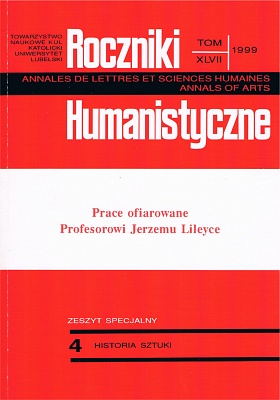An Unknown Painting of Christ Looking for His Rebes After the Flogging
Abstract
The first, most extensive part of the text gives information about the influence of the Spanish Jesuit monk, Alvarez de Paz, who was the author of the famous Meditationes, and the author of the notion of affective prayer, on the development of meditative passion literature. The author points to the changes in Spanish spirituality and their consequences. In the second part of this fragment examples are given of the effect of the discussed changes on painters' work and on the way visions and mystic states were translated into the language of painting. Names of painters of different origins are mentioned here, including ones coming from Poland, but first of all the painting by Bartolome Esteban Murillo is presented. Next the only presentation of the motif of looking for the robes that has been known up till now in Poland is discussed. The picture comes from Zakrzew in the Bydgoszcz province and was painted in the second half of the 18th century. In the next part of the article information is given about a painting that up to now is completely unknown to researchers studying art in Poland. The painting is in Jasna in Żuławy and it presents Christ's fall after the flogging. A more detailed discussion of the picture follows and then its iconographic description. A justified supposition is expressed that it could come from one of the dissolved Franciscan monasteries, for example from Kadyny near Elbląg. Also opinions are expressed that are polemic with respect to Professor Dobrzeniecki's statement suggesting connections of the discussed moment of passion mainly with folk art. The first polemic remark points to existence in Murillo's work of the presentation of Christ falling after the flogging and it suggests that the original that has not been found yet might be his picture. Another one is concerned with the Spanish origin of the motif in the picture from Jasna and it is supported by remarks about the construction of the composition of the painting. The sketch is closed with the suggestion that further search and studies should be conducted of the discussed iconographic motif and the painting from Jasna.
Copyright (c) 1999 Roczniki Humanistyczne

This work is licensed under a Creative Commons Attribution-NonCommercial-NoDerivatives 4.0 International License.





